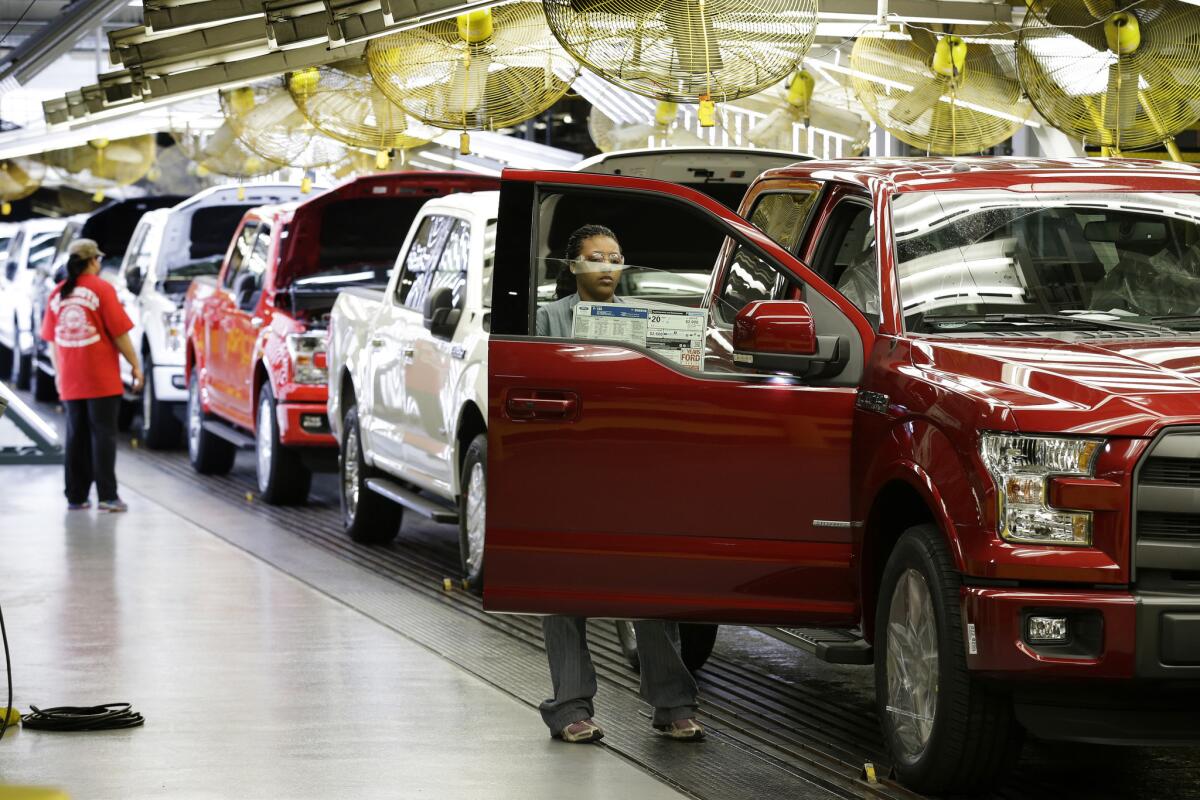Ford’s aluminum F-150 to cost more for repairs, insurer group says

Ford workers inspect 2015 aluminum-alloy body Ford F-150 trucks at the company’s plant in Claycomo, Mo., in March.
- Share via
Ford’s revolutionary aluminum-body F-150 pickup truck does well in most crash tests but is significantly more expensive to repair, according to an analysis by the Insurance Institute for Highway Safety.
That means buyers of the truck, the first to use the lighter-weight metal extensively, probably will pay more in out-of-pocket expenses after a crash and might ultimately have higher insurance premiums, the insurance trade group said.
The F-150 has been America’s bestselling vehicle for 33 consecutive years. The company has sold about 400,000, or about 4% of the autos sold so far this year.
The institute put the truck through a series of crash tests and found the vehicle’s performance varied, depending on the model.
The F-150 crew cab, which Ford calls the “SuperCrew,” posted “good” ratings for occupant protection in all five of the group’s crash tests. But while doing well in most of the tests, the smaller and lighter extended cab, or “SuperCab,” earned only a marginal rating for occupant protection in a small overlap front crash.
The test evaluates what happens when 25% of a vehicle’s front end on the driver’s side strikes a 5-foot-tall rigid barrier at 40 mph, with test dummies onboard. It simulates a wreck in which the front corner hits another car or solid object. Such crashes account for nearly a quarter of frontal crashes involving serious or fatal injury, according to the institute, and have been a difficult safety hurdle for many automakers.
“In a small overlap front crash like this, there’s no question you’d rather be driving the crew cab than the extended cab F-150,” said David Zuby, IIHS chief research officer.
SIGN UP for the free California Inc. business newsletter >>
The difference results from how Ford constructs the truck models. It added structural elements to the crew cab’s front frame but didn’t do the same for the extended cab, according to the insurance group.
“That shortchanges buyers who might pick the extended cab thinking it offers the same protection in this type of crash as the crew cab,” Zuby said. “It doesn’t.”
In the test, portions of the extended cab model penetrated the passenger cabin. The toepan, parking brake and brake pedal pushed 10 to 13 inches toward the dummy, and the dashboard was jammed against its lower legs. The steering column was shoved back nearly 8 inches, coming “dangerously close to the dummy’s chest,” the group said. The dummy’s head brushed by the front air bag before sliding off to the left and hitting the instrument panel.
Ford defended the truck’s safety record, noting that it earned the top National Highway Traffic Safety Administration crash-test ratings in all configurations and is the only truck to have received that recognition from the government.
The automaker said it is addressing its poor performance in the small overlap front crash test, noting that the test was adopted as the truck was being designed.
“We addressed the IIHS small overlap front crash in the 2015 F-150 SuperCrew, which accounts for 83% of 2015 F-150 retail sales, and are adding countermeasures in the SuperCab and Regular Cab in the 2016 model year,” said Mike Levine, a Ford spokesman.
Despite the small overlap test failure, the good ratings for the majority of the crash test demonstrate that aluminum trucks are just as safe as those built from steel, according to the insurance group.
“When people think of aluminum they think of a soda can,” said Russ Rader, a spokesman for IIHS, “but there’s no question that you can make an aluminum-bodied car or truck just as safe as a steel-bodied one.”
Still, while the aluminum truck might be safe, it is considerably more expensive to fix than a steel version, the tests found.
See the most-read stories this hour >>
The insurance group said a rear-corner crash at 10 miles per hour inflicted $4,738 of damage to the aluminum truck, almost 45% more than the $3,275 repair cost of an older steel F-150 with similar damage. A front-corner crash caused $4,147 in damage to the aluminum F-150, 10% more than the $3,759 for a steel truck.
Extra time to repair the aluminum body accounted for the higher price to fix the front crash damage, while higher parts costs pushed up the repair bill for the rear collision.
The institute researched the issue because automakers are increasingly using aluminum in vehicles to reduce weight to increase fuel efficiency in advance of stricter federal fuel economy regulations.
“From a simple bolt-on parts replacement to a more-involved removal and installation of entire body panels, fixing the aluminum F-150 is more expensive than repairing a steel-body F-150,” Zuby said.
The group warned this could lead to higher insurance rates.
“Insurance companies take repair costs into account when setting premiums, but there are many other factors that go into it too,” Rader said.
Ford disagrees with the findings.
“Real-world repair expenses for the 2015 F-150 are comparable or less than other full-size pickups and average $869 less than last year’s F-150s,” Levine said.
The automaker’s response was supported by Consumer Reports. Jake Fisher, the magazine’s automotive-test director, said that depending on which shop does the repair, an aluminum truck won’t necessarily be more expensive to repair.
“We looked at parts prices and how the repairs are done. While it always depends on what the damage is, in many cases the aluminum parts were not any more expensive than the steel parts for earlier F-150s,” Fisher said.
Truck owners should be sure to take a damaged vehicle to one of the 750 dealers and 800 independent body shops that have been certified to work on the truck’s aluminum components, he added.
“They have different tools and different methods to make the repair,” Fisher said.
Ford makes the F-150 with many different replacement panels, and a qualified body shop will install a replacement fairly quickly.
“They just replace the panel you need,” he said.
Shops that are not trained to work with the truck parts will use other methods that take longer and could add to labor expenses, Fisher said.
However, vehicles from other manufacturers that use aluminum in auto bodies don’t have the same level of support and probably will be more expensive to fix than steel cars, he said.
Follow me on Twitter (@LATimesJerry), Facebook and Google+.
MORE ON CARS
Tesla offers $1,000 credit to Model S buyers
VW beats Toyota as world’s biggest automaker
Better quality raises average age of cars on U.S. roads to 11.5 years







